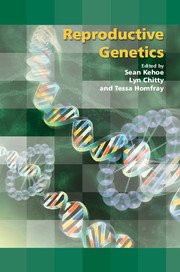Book contents
- Frontmatter
- Contents
- Participants
- Declarations of personal interest
- Preface
- 1 Genetic aetiology of infertility
- 2 Disorders of sex development
- 3 Preimplantation genetic diagnosis: current practice and future possibilities
- 4 Ethical aspects of saviour siblings: procreative reasons and the treatment of children
- 5 Epigenetics, assisted reproductive technologies and growth restriction
- 6 Fetal stem cell therapy
- 7 Prenatal gene therapy
- 8 Ethical aspects of stem cell therapy and gene therapy
- 9 Fetal dysmorphology: the role of the geneticist in the fetal medicine unit in targeting diagnostic tests
- 10 Fetal karyotyping: what should we be offering and how?
- 11 Non-invasive prenatal diagnosis: the future of prenatal genetic diagnosis?
- 12 Non-invasive prenatal diagnosis for fetal blood group status
- 13 Selective termination of pregnancy and preimplantation genetic diagnosis: some ethical issues in the interpretation of the legal criteria
- 14 Implementation and auditing of new genetics and tests: translating genetic tests into practice in the NHS
- 15 New advances in prenatal genetic testing: the parent perspective
- 16 Informed consent: what should we be doing?
- 17 Consensus views arising from the 57th Study Group: Reproductive Genetics
- Index
8 - Ethical aspects of stem cell therapy and gene therapy
Published online by Cambridge University Press: 05 February 2014
- Frontmatter
- Contents
- Participants
- Declarations of personal interest
- Preface
- 1 Genetic aetiology of infertility
- 2 Disorders of sex development
- 3 Preimplantation genetic diagnosis: current practice and future possibilities
- 4 Ethical aspects of saviour siblings: procreative reasons and the treatment of children
- 5 Epigenetics, assisted reproductive technologies and growth restriction
- 6 Fetal stem cell therapy
- 7 Prenatal gene therapy
- 8 Ethical aspects of stem cell therapy and gene therapy
- 9 Fetal dysmorphology: the role of the geneticist in the fetal medicine unit in targeting diagnostic tests
- 10 Fetal karyotyping: what should we be offering and how?
- 11 Non-invasive prenatal diagnosis: the future of prenatal genetic diagnosis?
- 12 Non-invasive prenatal diagnosis for fetal blood group status
- 13 Selective termination of pregnancy and preimplantation genetic diagnosis: some ethical issues in the interpretation of the legal criteria
- 14 Implementation and auditing of new genetics and tests: translating genetic tests into practice in the NHS
- 15 New advances in prenatal genetic testing: the parent perspective
- 16 Informed consent: what should we be doing?
- 17 Consensus views arising from the 57th Study Group: Reproductive Genetics
- Index
Summary
Introduction
A therapy can raise ethical issues because of:
■ its nature – what kind of therapy it is
■ its complexity
■ the risks it entails
■ the uncertainty surrounding estimates of risk and benefits in general or in the specific clinical situation
■ its cost and/or cost-effectiveness
■ the use to which it is being put.
Most stem cell and gene therapies that are likely to be developed will actualise some of these elements, for example initially most are likely to be costly. However, most will actualise them in ways that are not significantly different from complex surgical procedures or chemotherapy (at least in the foreseeable future). This could therefore be a very short chapter leading to the conclusion that stem cell and gene therapy raise no ethical issues that have not already been discussed extensively in the literature.
This conclusion might initially surprise some readers because it is so obvious that stem cell and gene therapy research has caused very significant and sustained ethical controversy. However, many of the intractable issues raised in these debates are of considerably less relevance to therapy than to basic research and they will mostly have been resolved at the policy level before the therapies move from research to therapy. Before clinical use becomes possible it will be decided, or in some cases has already been decided, whether there is something so problematic in deliberately making lasting genetic alterations or deriving stem cells from embryos that no therapy should be developed.
- Type
- Chapter
- Information
- Reproductive Genetics , pp. 123 - 130Publisher: Cambridge University PressPrint publication year: 2009



